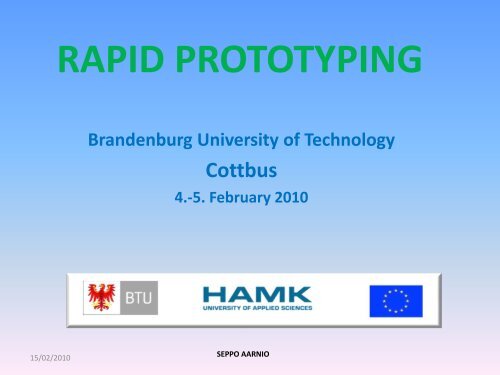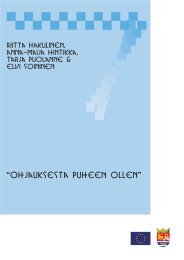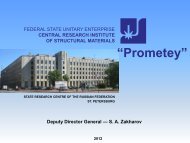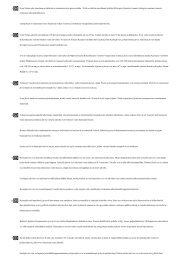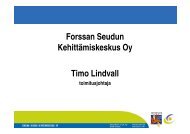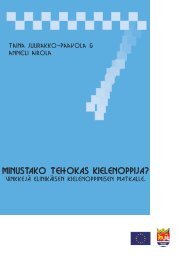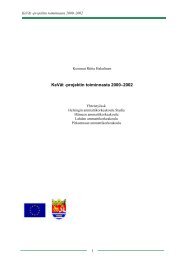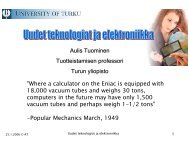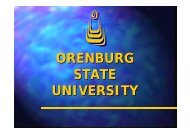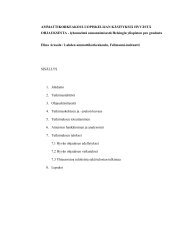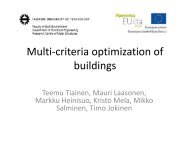RAPID PROTOTYPING
RAPID PROTOTYPING
RAPID PROTOTYPING
Create successful ePaper yourself
Turn your PDF publications into a flip-book with our unique Google optimized e-Paper software.
<strong>RAPID</strong> <strong>PROTOTYPING</strong>Brandenburg University of TechnologyCottbus4.-5. February 201015/02/2010SEPPO AARNIO
THREE PHASES OF DEVELOPMENTLEADING TO <strong>RAPID</strong> <strong>PROTOTYPING</strong>• MANUAL <strong>PROTOTYPING</strong>• SOFT or VIRTUAL <strong>PROTOTYPING</strong>• <strong>RAPID</strong> <strong>PROTOTYPING</strong> (of physicalparts)”Solid freeform fabrication”, ”Desktop manufacturing” or ”Layermanufacturing Technology”.15/02/2010 S.AARNIO
FUNDAMENTAL FABRICATION PROCESSESRPC K Chua, K F Leong, & C S Lim: Rapid Prototyping: Principles and Applications15/02/2010 S.AARNIO
1. OVERVIEW OF <strong>RAPID</strong> <strong>PROTOTYPING</strong>The term rapid prototyping (RP) refers to a class of technologiesthat can automatically construct physical models from Computer-Aided Design (CAD) data.The main advantage of the system is that almost any shape can beproduced. Time and money savings vary from 50 – 90 % comparedto conventional systems.Rapid prototyping techniques are often referred to solid free-formfabrication, computer automated manufacturing or layeredmanufacturing.The computer model is sliced into thin layers and the part isfabricated by adding layers on to of each other.Since 1988 more than twenty different rapid prototyping techniques haveemerged.15/02/2010 S.AARNIO
ADDITIVE PROCESSTypical layer thickness could be ≈ 0,05 – 0,15 mm15/02/2010S.AARNIO
2. THE BASIC PROCESSCREATING THE 3D CAD MODEL OF THE DESIGNCONVERTING THE CAD MODEL INTO STL FORMATSLICING THE STL FILE INTO THIN LAYERSCONSTRUCTING THE MODEL ONE LAYER ATOP ANOTHERCLEANING AND FINISHING THE MODEL15/02/2010 S.AARNIO
2.1 CAD MODEL CREATION:First the object to be build is modeled:• using a CAD software package• or by using a laser scanner or a CoordinateMeasuring Machine (CMM). (”Reverseengineering””)15/02/2010 S.AARNIO
2.2 CONVERSION TO STL FORMAT:The standard data interface between CAD sofware and themachine is the STL-format (Stereolithography).An STL-file approximates the shape of a part using triangularfacets. Small facets produce a high quality surface.15/02/2010 S.AARNIO
Since the .stl format is universal, this process is identicalfor all of the RP build techniques.3.2 SLICE THE STL FILE:http://www.youtube.com/watch?v=80aXU5q2KggThe program may also generate an auxiliary structure toSupport the model during the build15/02/2010 S.AARNIO
4.2 LAYER BY LAYER CONSTRUCTION:The fourth step is the actual construction of the part.Using one of several techniques (described later) RPmachines build the model layer by layer.The material´s initial states are:• LIQUID• SOLID or• POWDER15/02/2010 S.AARNIO
5.2 CLEAN AND FINISH:• Removement of the part from the machine• Detaching any supports• Aftercure (some photosensitive materials)• Cleaning and surface treatment• Possible painting etc15/02/2010 S.AARNIO
3. GENERAL ADVANTAGES OF RP• Almost any shape or geometric feature can be produced.• Reduction in time and cost (could range 50 – 90%. Wohler)• Errors and flaws can be detected at an early stage.• RP/RM can be used in different industries and fields of life(medicine, art and architecture, marketing..)• Discussions with the customer can start at an early stage.• Assemblies can be made directly in one go.• Material waste is reduced.• No tooling is necessary.• The designers and the machinery can be in separate places.•15/02/2010 S.AARNIO
4. SOME DISADVANTAGES OF RP• The price of machinery and materials.• The surface is usually rougher than machined surfaces.• Some materials are brittle.• The strength of RP-parts are weaker in z-direction than inother.•15/02/2010 S.AARNIO
5. APPLICATIONS OF RPTechnology15/02/2010 S.AARNIO
15/02/2010 S.AARNIO
15/02/2010 S.AARNIO
The task was to test different alternative INTAKE MANIFOLDS. Theparts (three) were made of Windform XT with laser sintering. By usingSLS the time from desktop to product took only about 10 % of the timeearlier.15/02/2010 S.AARNIO
Wind tunnel tests15/02/2010 S.AARNIO
15/02/2010 S.AARNIO
MedicineModels of skulls etc can be used fortraining of surgical operations15/02/2010 S.AARNIO
Parts made of titamium are used for replacements15/02/2010 S.AARNIO
These siamese twins were succesfully separated. Theoperation was planned with models of the skulls.15/02/2010 S.AARNIO
Architecture15/02/2010 S.AARNIO
6. RP-TECHNOLOGIES• Stereolithography (SLA)• Fused Deposition Modeling (FDM)• Selective Laser Sintering (SLS)• Laminated Object Manufacturing (LOM)• 3D Printing• Direct metal laser sintering (DMLS)15/02/2010 S.AARNIO
6.1 STEREOLITHOGRAPHYSLAStereolithography is the most widely used RP-technology. It can produce highlyAccurate and detailed polymer parts. SLA was the first RP-process, introducedin 1988 by 3D Systems Inc.SLA uses a low-power, highly focused UV laser to produce a threedimensional object in a vat of liquid photosensitive polymer.Abbreviation:Material type:Materials:Min layer thickness:Surface finish:Build speed:Applications:SLALiquid (Photopolymer)Thermoplastics (Elastomers)0,02 mmSmoothAverageForm/fit testing, Functional testing, Very detailed parts,Presentation models, Snap fits..15/02/2010 S.AARNIO
SLAhttp://www.youtube.com/watch?v=eJ7s-1XvDFw&feature=related15/02/2010 S.AARNIO
6.2 FUSED DEPOSITION MODELINGFDMFDM was developed by Stratasys. In this process, a plastic or wax material isextruded through a nozzle that traces the part´s cross sectional geometry layerby layerAbbreviation:Material type:Materials:Min layer thickness:Surface finish:Build speed:Applications:FDMSolid (Filaments)ABS, Polycarbonate, Polyphenylsulfonite; Elastomers0,15 mmRoughSlowForm/fit testing, Functional testing, Small detailed parts,Presentation models…15/02/2010 S.AARNIO
FDMhttp://www.youtube.com/watch?v=oYLjyI5honM&feature=related15/02/2010 S.AARNIO
6.3 SELECTIVE LASER SINTERING SLSSLS was patented in 1989. The basic concept of SLS is similar to that ofSLA. It uses a moving laser beam to trace and selectively sinter powderedpolymer and/or metal composite materials. The powder is kept at elevatedtemperature. Unlike SLA, special support structures are not requiredbecause the excess powder in each layer as a support.With the metal composite material, the SLS process solidifies a polymerbinder material around steel powder (diameter ca. 0.1 mm) one slice at atime forming the part.The part is then placed in a furnace (>900 °C), where the polymer binder isburned off and the part is infiltrated with bronze to improve its density.SLS allows for a wide range of materials, including nylon, glass-filled nylon,Truform (investment casting) and metal composites.15/02/2010 S.AARNIO
SLSAbbreviation:Material type:Materials:Min layer thickness:Surface finish:Build speed:Applications:SLSPowder (Polymer)Thermoplastics: Nylon, Polyamide and Polystyrene;Elastomers; Composites0,10 mmAverageFastForm/fit testing, Functional testing, Less detailed parts, Partswith snap-fits & living hinges, High heat applications..15/02/2010 S.AARNIO
SLShttp://www.youtube.com/watch?v=ShX_qXSTj_E&feature=related15/02/2010 S.AARNIO
6.4 LAMINATED OBJECT MANUFACTURINGLOMThe main components of the system are a feed mechanism that advances asheet over a build platform, a heater roller to apply pressure to bond the to thelayer below, and a laser to cut the outline of the part in each sheet layer. Aftereach cut is completed, the platform lowers by a depth equal to the sheetthickness (0.05 – 0,5 mm). The laser cuts the outline and the process isrepeated until the part is completed. After a layer is cut, the extra materialremains in place to support the part.Abbreviation:Material type:Materials:Min layer thickness:Surface finish:Build speed:Applications:LOMSolid (Sheets)15/02/2010 S.AARNIOThermoplastics such as PVC; Paper; Composites (Ferrousmetals; Non-ferrous metals; Ceramics)0,05 mmRoughFastForm/fit testing, Less detailed parts, Rapid tooling patterns…
LOMhttp://www.youtube.com/watch?v=Z1WNA6tdfWM&feature=related15/02/2010S.AARNIO
6.4 3D PRINTING3DPThree Dimensional Printing (3DP) technology was developed at the MITand licensed to several corporations. The process is similar to the SLSprocess, but instead of using a laser to sinter the material, an ink-jetprinting head deposits a liquid adhesive that binds the material. Materialoptions are somewhat limited but are inexpensive relative to otheradditive processes. 3D printing is quite fast, typically 2 – 4 layers/minute.However, the accuracy, surface finish, and part strength are not as goodas some other additive processes.At the end the part is infiltrated with a sealant to improve strength andsurface finish.15/02/2010 S.AARNIO
3DPAbbreviation:Material type:Materials:Min layer thickness:Surface finish:Build speed:Applications:3DPPowderFerrous metals such as Stainless steel; Non-ferrous metalssuch as Bronze; Elastomers; Composites; Ceramics0,05 mmRoughVery FastConcept models, Limited functional testing, Architectural &landscape models, Consumer goods & packaginghttp://www.youtube.com/watch?v=uAt2xD1L8dw15/02/2010 S.AARNIO
15/02/2010 S.AARNIO3DP
6.5 DIRECT METAL LASER SINTERINGDMLSDMLS technology was developed jointly by Rapid Prototyping Innnovations(RPI) and EOS Gmbh in 1994. It was the first commercial RP-method to producemetal parts in a single process. Metal powder (20 µm diameter) without binder iscompletely melted by scanning of a high power laser beam. The density of aproduced part is about 98 %. SLS has about 70 %. One advantage of DMLScompared to SLS is the small size of particles which enables very detailed parts.Abbreviation:Material type:Materials:Min layer thickness:Surface finish:Build speed:Applications:DMLSPowder (Metal)Ferrous metals such as Steel alloys, Stainless steel, Tool steel;Aluminium, Bronze, Cobalt-chrome, Titanium, Ceramics..0,02 mmAverageFastForm/fit testing, Functional testing, Rapid tooling, High heatapplications, Medical implants, Aerospace parts..15/02/2010 S.AARNIO
15/02/2010 S.AARNIODMLS
THANK YOU FOR YOURATTENTION !HAVE A NICE DAY !15/02/2010 S.AARNIO


